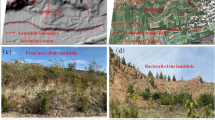Abstract
As one of the important limit equilibrium methods, the transfer coefficient method or imbalance thrust force method for landslide and slope stability has been proposed by Chinese engineers for decades. But the permissible static conditions for inter-slice interfaces are not completely considered for the method. A stability coefficient of inter-slice interfaces is introduced to ensure that the stability of inter-slice interfaces is not less than that of critical slip surface of a slope or landslide. The full computation procedure of the improved transfer coefficient method is presented. Comparison was made among the proposed method, some classical limit equilibrium methods, and numerical simulation method using the shear strength reduction technique for landslide examples with or without groundwater. The calculation results obtained using the proposed method is in good agreement with those determined by other methods. However, the proposed method provides a more conservative assessment of the slope stability than the traditional transfer coefficient method. In addition, the analysis of landslide examples shows that the factor of safety of landslides decreases to some extent with the stability coefficient of inter-slice interfaces in increase. Consequently, in order to eliminate much more conservative assessment of slope stability, it is suggested that the stability coefficient is assumed the same as the factor of safety of landslides.










Similar content being viewed by others
References
Zheng H (2012) A three-dimensional rigorous method for stability analysis of landslides. Eng Geol 145(9):30–40
Zhou XP, Chen H (2013) Analysis of stability of three-dimensional slopes using the rigorous limit equilibrium method. Eng Geol 160(6):21–33
Lu KL, Zhu DY (2016) A three-dimensional rigorous method for stability analysis and its application. Bull Eng Geol Environ 75:1445–1457
Lowe J, Karafiath L (1960) Stability of earth dams upon drawdown. In: Panamerican conference on soil mechanics and geotechnical engineering, vol 2, Mexico City, pp 537–552
Morgenstern NR, Price VE (1965) The analysis of the stability of general slip surfaces. Geotechnique 15(1):79–93
Spencer E (1967) A method of analysis of the stability of embankments assuming parallel interslice forces. Geotechnique 17(1):11–26
US Army Corps of Engineers (1967) Stability of slopes and foundations: engineering manual, Vicksburg, MS
Janbu N (1973) Slope stability computations. In: Hirschfield E, Poulos S (eds) Embankment dam engineering, casagrande memorial. Wiley, New York, pp 47–86
Sarma KS (1979) Stability analysis of embankments and slopes. J Geotech Eng ASCE 105(12):1511–1524
China Railway Eryuan Engineering Group Co. Ltd (1983) Design and calculation of stabilizing piles. China Railway Press, Beijing (in Chinese)
Ministry of Housing and Urban-Rural Development of the People’s Republic of China (2012) GB50007-2011: code for design of building foundation, Beijing, China (in Chinese)
Fang Y (2008) Stability based method for determining loadings on retaining structures of slope. J Eng Geol 16(2):190–195 (in Chinese)
Chen Z (2007) The limit analysis in soil and rock: a mature discipline of geomechanics. J Zhejiang Univ Sci A 8(11):1712–1724
Zhang J, Wang H (2007) Discussion on transfer coefficient method and improved one for calculation of landslide thrust. Eng Constr 21(6):932–934 (in Chinese)
Zienkiewicz OC, Humpheson C, Lewis RW (1975) Associated and non-associated visco-plasticity and plasticity in soil mechanics. Geotechnique 25:671–689
Dawson EM, Roth WH, Drescher A (1999) Slope stability analysis by strength reduction. Géotechnique 49(6):835–840
Fellenius W (1936) Calculation of the stability of earth dams. In: Proceedings of 2nd congress on large dams, vol 4, Washington, pp 445–462
Bishop AW (1955) The use of the slip circle in the stability analysis of slopes. Geotechnique 5(1):7–17
Acknowledgements
The research was supported by the National Natural Science Foundation of China (Grant No. 51578466) and the Program for New Century Excellent Talents in University (NCET-13-0976).
Author information
Authors and Affiliations
Corresponding author
Rights and permissions
About this article
Cite this article
Xiao, S. Improved Transfer Coefficient Method for Stability Analysis of a Landslide with Polyline Slip Surface. Indian Geotech J 49, 595–602 (2019). https://doi.org/10.1007/s40098-018-0331-5
Received:
Accepted:
Published:
Issue Date:
DOI: https://doi.org/10.1007/s40098-018-0331-5




